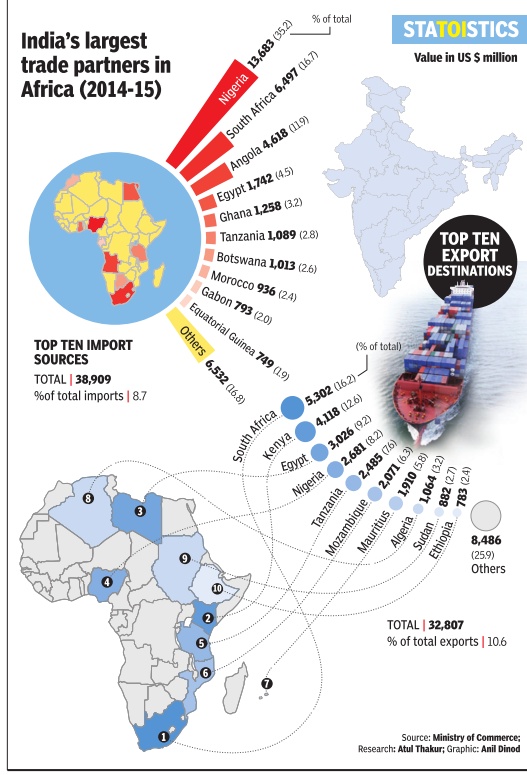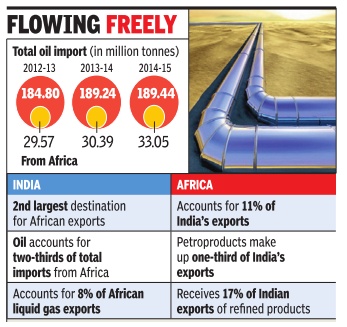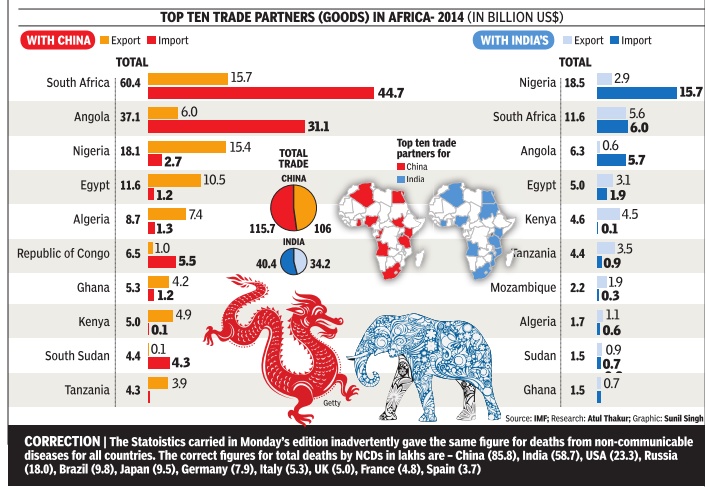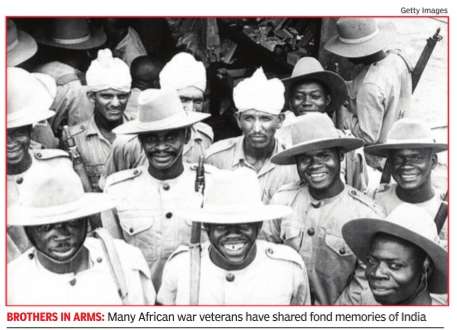Africa-India relations


This is a collection of articles archived for the excellence of their content. |
Contents |
History
Indian and African soldiers in WW II
Back during WW2, African troops fought alongside us even though their efforts haven't got the same recognition
`La la la it's hard working for you, captain“ goes a song.
It's an African unit trying to keep up morale in the treacherous jungles of Burma in the Second World War.
Indians and Africans were fighting the war on the same side. Military historians say a unique and potent weapon in the form of the 14th Army was forged in India by unifying the fighting potential of different races and cultures.
The core of the 14th Army was Indian with troops from the subcontinent constituting 60-65% of the force. Only 13% of this army was ethnic British. But of the rest, 90,000 (some historians say up to 1,20,000) were black African troops. In the summer of 1943, troop carriers brought these Africans to India and Ceylon from Chad, Gold Coast, Gambia, Kenya, Sierra Leone, Tanzania, South Africa and Nigeria. Of the 90,000 men coming from the Dark Continent to defend the Indian Empire from the Empire of Japan, over 50% were Nigerians.
Soldiers of the Japanese empire -one of the most racist regimes in history -also thought Africans were cannibals. A war veteran named Estos Hamiss was quoted by David Killingray and Martin Plaut in their book, Fighting For Britain: African Soldiers in the Second World War: “The Japanese were very much afraid of East African Division (black people). The Japanese do claim that the African eat human flesh.When the EA soldiers killed an enemy (Japanese), they set fire and roast him.“
The same book also quotes one Musa Kihwelo who had served in Burma with King's African Rifles (a highly decorated regiment in which former US president Barack Obama's grandfather, Hussein Onyango Obama, also served as a cook in Burma) about how men of the 6th battalion terrified captured Japanese soldiers by killing one or two and pretending to eat them. “While they started to pretend to eat the `meat' the other Japanese captives who survived would flee for their lives.This was intentional so that they would spread the news that they were fighting against the cannibals who particularly enjoyed eating Japanese flesh,“ Kihwelo says, adding that it was an “inhuman trick“ that none of the European officers knew about. However, it was the Japanese who were accused of cannibalism in the later stages of the war, and even tried for it.
The Second World War brought together distinct, often irreconciliable cultures. African troops fought shoulder to shoulder with Indians, British, Australians, Chinese and Americans. Thousands were killed or wounded. The dead are commemorated in various war cemeteries in India, Burma and elsewhere.At the Imphal War Cemetery maintained by Commonwealth War Graves Commission, 45 black Africans are commemorated. But unlike other Allied soldiers, there are no details of these soldiers in the casualty list. Even the details of Indian labourers are mentioned, but not of black troops. Why?
“Firstly, the British Army did not keep detailed records for many of the African servicemen that enlisted in their forces and, therefore, there was very little for us to add to our records when details of casualties were passed to us,“ says Peter Francis of CWGC. “The second reason is that much of the additional information in our records was supplied by families after the war. As part of that process, the CWGC wrote to families but this approach didn't work for many African families -particularly those that had oral traditions rather than written.“
Many historians and war veterans say this reflects how the black African contribution has been completely airbrushed in western records of WWII.
But many African veterans of the war have shared fond memories of India and Indians on various platforms. “Indians are wonderful people of a wonderful country. Their women particularly are very beautiful with long, flowing hair down to the waist,“ a veteran recalls in a documentary . Another says Indians, Africans and African-Americans were like brothers. Africans were particularly inspired by India's freedom movement that was under way at that time. One soldier recalled meeting Gandhi in Madras. He saluted Gandhi like a soldier and asked him what India would do for Africa. To that, Gandhi apparently replied that India would give Africans moral support provided they fought the British non-violently .
Army
Second World War
HIGHLIGHTS
The core of the 14th Army was Indian with troops from the subcontinent constituting 60-65% of the force.
Only 13% of this army was ethnic British.
But of the rest, 90,000 were black African troops.
"La la la it's hard working for you, captain" goes a song. No, it's not a Congress worker singing to say how difficult it was to run a successful campaign for Captain Amarinder Singh; it's an African unit trying to keep up morale in the treacherous jungles of Burma in the Second World War.
Long before vigilante mobs went on a rampage in Greater Noida, Indians and Africans were fighting the war on the same side. Military historians say a unique and potent weapon in the form of the 14th Army was forged in India by unifying the fighting potential of different races and cultures.
The core of the 14th Army was Indian with troops from the subcontinent constituting 60-65% of the force. Only 13% of this army was ethnic British. But of the rest, 90,000 (some historians say up to 1,20,000) were black African troops. In the summer of 1943, troop carriers brought these Africans to India and Ceylon from Chad, Gold Coast, Gambia, Kenya, Sierra Leone, Tanzania, South Africa and Nigeria. Of the 90,000 men coming from the Dark Continent to defend the Indian Empire from the Empire of Japan, over 50% were Nigerians.
Seventy years hence, the country that these men defended is seeing uninhibited displays of racism. Greater Noida is the latest example, where mobs have attacked black Africans, calling them 'habshi', drug peddlers, even cannibals. Soldiers of the Japanese empire — one of the most racist regimes in history — also thought Africans were cannibals.
A war veteran named Estos Hamiss was quoted by David Killingray and Martin Plaut in their book, Fighting For Britain: African Soldiers in the Second World War: "The Japanese were very much afraid of East African Division (black people). The Japanese do claim that the African eat human flesh. When the EA soldiers killed an enemy (Japanese), they set fire and roast him." The same book also quotes one Musa Kihwelo who had served in Burma with King's African Rifles (a highly decorated regiment in which former US president Barack Obama's grandfather, Hussein Onyango Obama, also served as a cook in Burma) about how men of the 6th battalion terrified captured Japanese soldiers by killing one or two and pretending to eat them. "While they started to pretend to eat the 'meat' the other Japanese captives who survived would flee for their lives. This was intentional so that they would spread the news that they were fighting against the cannibals who particularly enjoyed eating Japanese flesh," Kihwelo says, adding that it was an "inhuman trick" that none of the European officers knew about. However, it was the Japanese who were accused of cannibalism in the later stages of the war, and even tried for it.
The Second World War brought together distinct, often irreconciliable cultures. African troops fought shoulder to shoulder with Indians, British, Australians, Chinese and Americans. Thousands were killed or wounded. The dead are commemorated in various war cemeteries in India, Burma and elsewhere. At the Imphal War Cemetery maintained by Commonwealth War Graves Commission, 45 black Africans are commemorated. But unlike other Allied soldiers, there are no details of these soldiers in the casualty list. Even the details of Indian labourers are mentioned, but not of black troops. Why?
"Firstly, the British Army did not keep detailed records for many of the African servicemen that enlisted in their forces and, therefore, there was very little for us to add to our records when details of casualties were passed to us," says Peter Francis of CWGC. "The second reason is that much of the additional information in our records was supplied by families after the war. As part of that process, the CWGC wrote to families but this approach didn't work for many African families — particularly those that had oral traditions rather than written." Many historians and war veterans say this reflects how the black African contribution has been completely airbrushed in western records of WWII. But many African veterans of the war have shared fond memories of India and Indians on various platforms. "Indians are wonderful people of a wonderful country. Their women particularly are very beautiful with long, flowing hair down to the waist," a veteran recalls in a documentary. Another says Indians, Africans and African-Americans were like brothers.
Africans were particularly inspired by India's freedom movement that was under way at that time. One soldier recalled meeting Gandhi in Madras. He saluted Gandhi like a soldier and asked him what India would do for Africa. To that, Gandhi apparently replied that India would give Africans moral support provided they fought the British non-violently.
Economic relations
2018: India pledges $400m to Rwanda, Uganda
India pledges $400m aid to Rwanda, Uganda, July 25, 2018: The Times of India
India has extended over $400 million lines of credit (LOC) for Rwanda and Uganda during Prime Minister Narendra Modi’s visit to the two countries on his way to South Africa for the upcoming Brics summit. Significantly, India also signed agreements for cooperation in the defence sector with the two east African nations.
After the $200 million LOC for Rwanda, India on Tuesday extended two lines of credit worth nearly $200 million to Uganda in energy infrastructure, agriculture and dairy sectors as the PM held wide-ranging talks with President Yoweri Museveni and discussed ways to strengthen the bilateral ties.
Modi, who arrived in Kampala on a two-day visit to Uganda — the first bilateral tour by an Indian PM since 1997, held one-on-one meeting with President Museveni followed by a delegationlevel talks to review all aspects of bilateral relations.
Trade
Africa’s trade and China and India
The Times of India, Nov 03 2015

With its young population and resources, Africa is poised to play an important economic role in future and hence its markets and resources are being eyed by major countries including China and India. When compared to China, India has a long way to go in its trade with the continent.In 2014, China's total trade in goods with the continent was $222 billion, about three times the figure for India. South Africa, Angola, Nigeria and Egypt (not necessarily in that order) are the largest trading partners for both India and China and constitute more than half of both countries trade with the continent
YEAR-WISE DEVELOPMENTS
2020: India 5th largest investor in Africa
February 13, 2020: The Times of India
India is opening 18 new embassies in Africa, to take the total number of Indian missions to 47 out of a total of 54 countries in Africa, foreign secretary Harsh Vardhan Shringla said on Wednesday. Nine of the 18 new missions have already opened. In terms of India’s development cooperation, over two-thirds of its LOCs (lines of credit) in the past decade have been offered to African nations.
“Currently 189 projects in 42 African countries, valued at US$ 11.4 billion, are being implemented under Indian LoCs. These projects range from drinking water schemes to irrigation, solar electrification, power plants, transmission lines, cement plants, technology parks, and railway infrastructure,” said Shringla, addressing a conference titled Understanding Africa: Continuity and Change.
The picture on trade and investment is encouraging, he said. “India-Africa trade in the previous year was valued at $69 billion, a 12% annual increase. The Duty Free Tariff Preference (DFTP) Scheme announced by India has benefited African nations by extending duty free access to 98.2% of India’s total tariff lines. Thirty-eight African nations benefit from the DFTP Scheme. India has become the fifth largest investor in Africa with cumulative investments of $54 billion. Indian investment has created thousands of jobs for local citizens,” he said.
